Bb Major Barre Chord
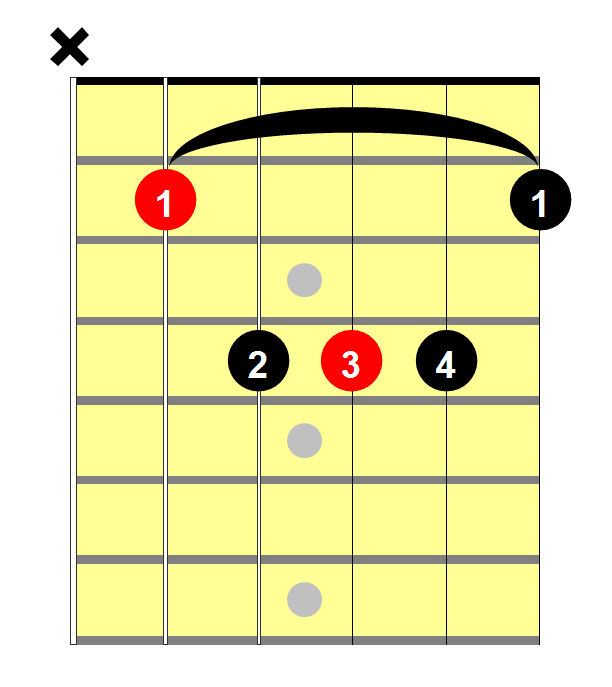
Notice how without the barre, this chord shape is exactly the same as the A chord.
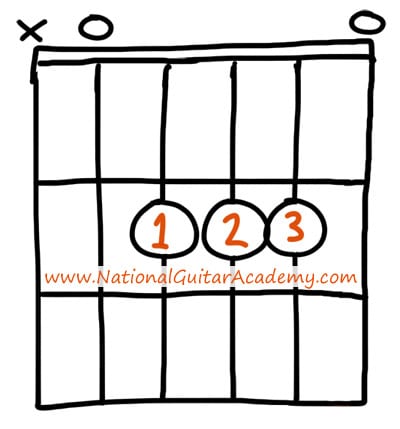
Bb Minor Barre Chord
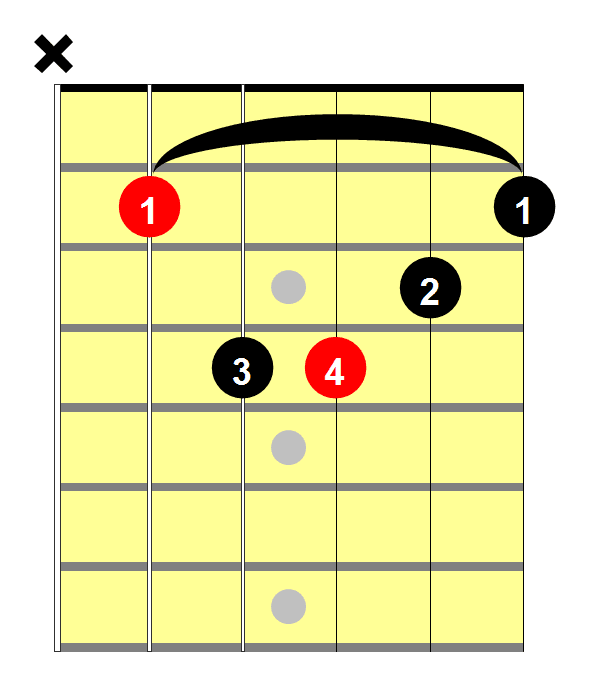
The minor barre chord shape on the A string, is exactly the same as a A minor chord.
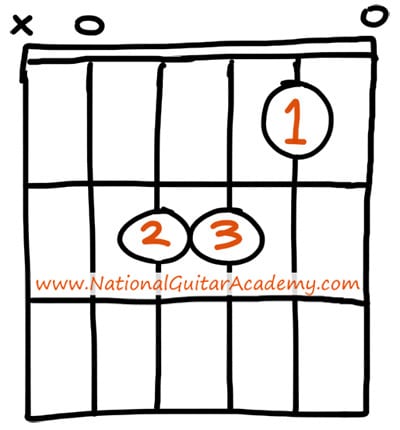
Moveable Shapes
To change the key of a chord, we must change the root note.
For each of our A chord shapes, the root note is on the A string.
To do this, we must know the root notes on the A string, here they are:

For example, to play a C major chord with the root on the A string.
- Move your barre chord shape to the 3rd fret.
To play a Eb minor chord with the root on the A string.
- Move your A minor chord shape to the 6th fret of the A string.
The root note on the A string, determines the key of the chord.
Intermediate Guitar Lessons | Rhythmic Techniques That Will Enhance Your Musicality
In this intermediate guitar lessons, we’re going to work on enhancing your strumming & musicality.
The first technique we’re going show you is how to use ‘string slapping’ to add a percussive sound to your guitar chords.
In this video Mike explains this cool technique:
To get a close up of this classic technique, watch this video:
Intermediate Guitar Lessons | Palm Muting
A great way to add musicality to your rhythm playing is to use palm muting technique.
This techniques adds texture and dynamics to your playing.
This technique is used in rock and metal music, it sounds huge!
To do this technique:
- Pick a chord, you can use any chord.
- Pick the chord whilst simultaneously placing the side of your picking hand by the bridge of your guitar.
- Pick your chord whilst muting it with your palm.
Your rhythm playing should sound tight and chunky!
To learn more about palm muting, go here: Palm Muting: An Essential Guide
Intermediate Guitar Lessons | Learn Lead Guitar Scales
If you want to become an amazing lead guitarist, you should learn how to play lead guitar scales.
The two most common lead guitar scales are:
- The Minor Pentatonic Scale.
- The Major Pentatonic Scale.
Here are the most common patterns for each of those scales:
The Minor Pentatonic Scale

This scale is in the key of A minor.
The Major Pentatonic Scale
 This scale is in the key of C major.
This scale is in the key of C major.
Download our lead guitar cheat-sheet to make things easier
It's hard to understand which scales work with which keys.
So we created a cheat-sheet! A key and scale-finder that you can use again and again.

Get your personalised guitar-learning plan 🎸
Get a custom guitar-learning plan here: Click here for GuitarMetrics™
World-Class Guitar Courses 🌎
Learn from the world's best guitar educators: Click here for our guitar courses
Moveable Scale Shapes
The great thing about both of these scale patterns is that they can be moved up and down the fret board.
All we have to do is our change the root note on the low E string.

If you want to play a minor pentatonic scale in the key of B.
- Start this scale on the 7th fret of the low E string.
This technique works for the major pentatonic scale too.
For example, if you want to play a major pentatonic scale in the key of F#.
- Start your scale on the 2nd fret of the low E string.
The five most common major keys are:
- C, A, G, E and D.
The five most common minor keys are:
- A, F#, E, C# and B.
Here are the intermediate guitar lessons tabs for ALL of those keys.
A Major Pentatonic Scale

G Major Pentatonic Scale
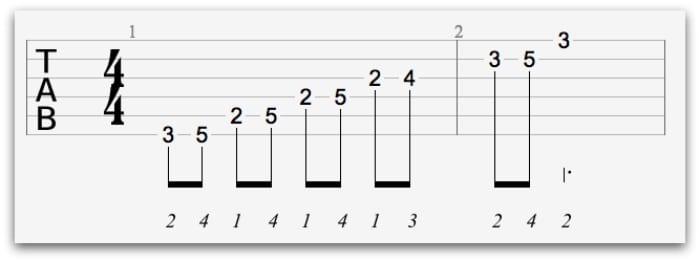
E Major Pentatonic Scale
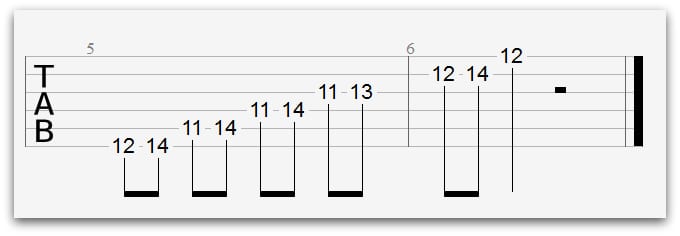
D Major Pentatonic Scale

F# Minor Pentatonic Scale

E Minor Pentatonic Scale

C# Minor Pentatonic Scale

B Minor Pentatonic Scale

If you fancy an added challenge, try learning these diagonal patterns.
A Minor Pentatonic Scale | Diagonal Pattern #2
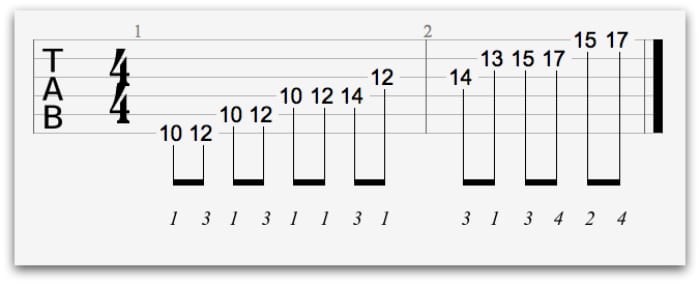
A Minor Pentatonic Scale | Diagonal Pattern #2

To learn more scales go here:
- Learn Guitar Scales In 8 Easy Steps
- Guitar Scales Tabs: The Ultimate Guide
- E Minor Pentatonic Scale: The Ultimate Guide
- Jazz Scales – 6 Scales That You Need To Know
How do I use these scales?
If you want to learn how to use guitar scales, you must know how to work out musical keys.
Here’s a quick & easy trick which will help you work out the musical key of a song:
If you’re playing in a major key, you can use a major scale. If you’re playing in a minor key, you can use a minor scale.
So, if something was in the key of C major.
- You could play a C major pentatonic.
If you were playing in the key of A minor.
- You could use a A minor pentatonic scale.
For more information on how to play lead guitar, go here: How To Play Lead Guitar
How do I work out a musical key?
Here’s a cool trick to use if you want to work out a musical key.
Look at the first and last chord of a chord progression.
Most of the time, the key of a song is determined by the first and last chord of a song.
Let’s try this method out, here’s a classic chord progression.
To learn more about musical keys, go here: Guitar Keys: An Essential Guide
E Major | G# Minor | C# Minor | E Major
What key is this chord progression?
- The first chord is E major.
- The last chord is E major.
- Therefore, this progression is in E major.
To improvise over this chord progression you could use:
- A E Major Pentatonic Scale.
Let’s try another chord progression. What key is this in?
A Minor | D Minor | E Minor | A Minor
- The first chord is A minor.
- The last chord is A minor.
- Therefore it’s in A minor.
What scale could I use over this progression?
The A minor pentatonic scale would work perfectly over this chord progression.
Intermediate Guitar Lessons | 3 Awesome Guitar Tabs
One of the best things about being an intermediate guitarist is learning more advanced guitar riffs.
In this intermediate guitar lessons, we’re going to show you 3 of the most iconic guitar riffs of all time.
Intermediate Guitar Riff #1 ‘Sweet Child O’ Mine’ by Guns ‘n’ Roses
Every intermediate guitarist should know this epic guitar riff.
Here are 3 reasons why it’s perfect for intermediate guitarists:
- It sounds fantastic and is great fun to play.
- It’s a challenge!
- Learning this riff is a great way of enhancing your picking technique.
Let’s listen to this classic riff in context:
Here’s the tab:
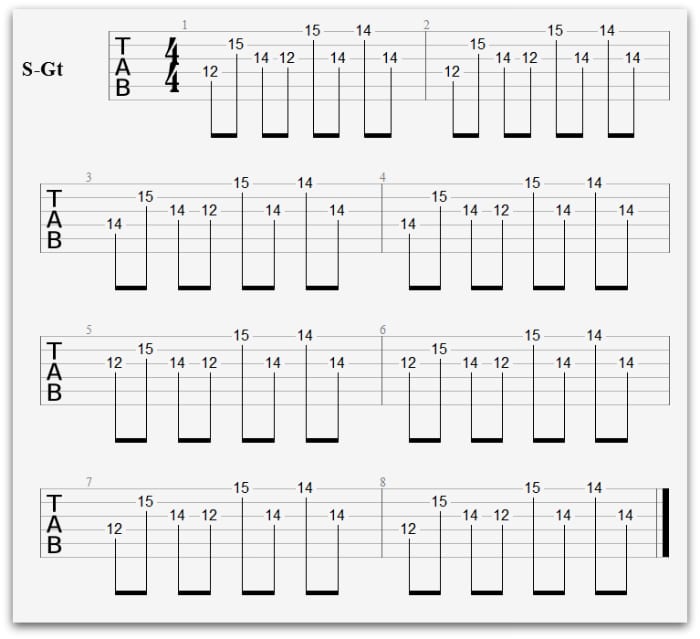
Intermediate Guitar Riff #2 ‘Purple Haze’ by Jimi Hendrix
This riff is one of the most iconic rock riffs of all time!
If you want to become an epic intermediate guitarist, you should learn this riff.
Here’s why:
- It’s one of the most popular guitar riffs of the 60s!
- If you want to sound like a rockstar you must learn this riff.
- This riff is perfect for perfecting your picking technique.
Let’s listen to it:
Here’s the tab:

Intermediate Guitar Riff #3 ‘Under The Bridge’ by The Red Hot Chili Peppers
Even though this riff isn’t as rocky as the previous two.
It’s certainly up there as one of the most iconic riffs of all time!
Here are 3 reasons why you should learn this epic riff:
- This riff is perfect if you want to practice barring technique.
- It’s a challenge to pick!
- It’s SO iconic, everyone will be impressed if you can nail this riff.
Here’s the song:
Here’s the tab:
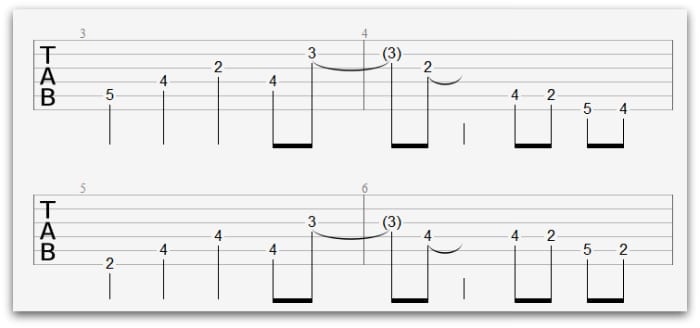
To learn more guitar riffs, go here: Guitar Tabs For Beginners: 20 Easy Songs That Sound Great
Intermediate Guitar Lessons | Learn Guitar Theory
It is impossible to become a advanced guitarist without learning guitar theory.
Many guitarists shy away from guitar theory, however you must understand guitar theory if you want to understand how music works.
In this intermediate guitar lessons, we’re going to take you through the basics of guitar theory.
The first step to understanding guitar theory is to understand how chords and scales work together.
Guitar Theory | Understanding Guitar Scales and Chords
The two most common guitar scales are:
- The Major Scale.
- The Minor Scale.
All music is built off of these scales.
Here’s a tab and chord box of these two scales:
The Major Scale
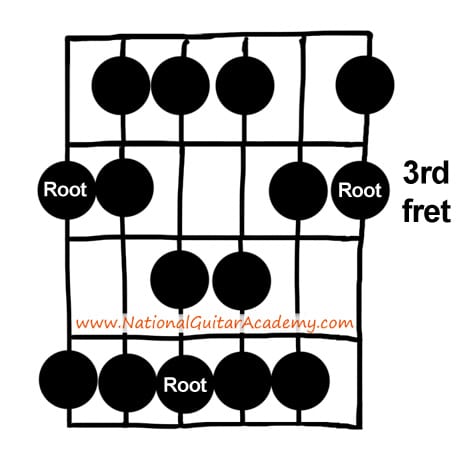

For the purpose of this, we’re going to keep the major scale in the key of C.
Major Chords
Scales and chords are directly related.
For every major scale, there’s a major chord.
Major chords are built off of the 1st, 3rd and 5th degrees of the scale.

Each of those notes make a C major chord.
Try this:
- Play your scale.
- Find the 1st note of the scale.
- Find the 3rd note of the scale.
- Find the 5th note of the scale.
Once you’ve done this, play each of these notes.
Then, play a C major chord. Can you hear how they sound similar? This is because the 1st, 3rd and 5th notes of the C major scale, make up a C major chord.
To learn more about the key of C, go here: Understanding The Chords In The Key of C
The Minor Scale
For this scale, we’re going to use the key of A minor.
Here’s the scale and chord box:
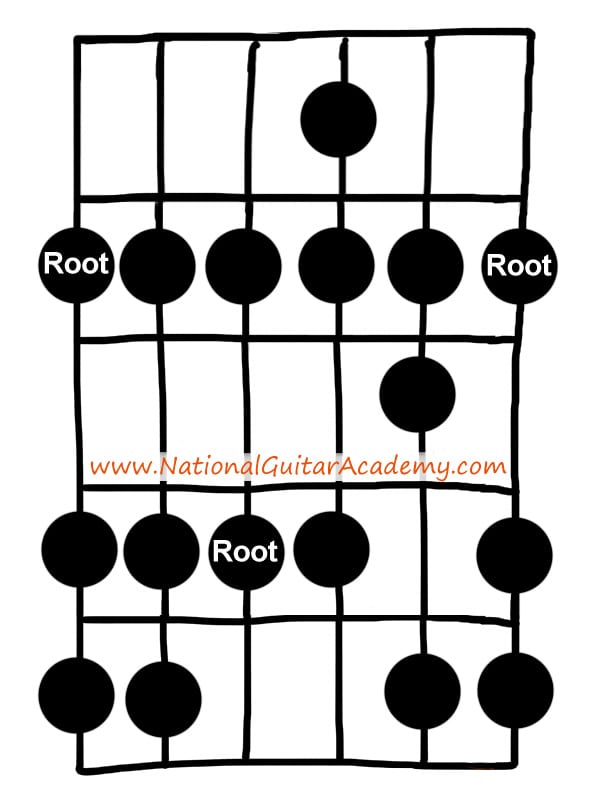
To play this scale in the key of A, start it on the 5th fret.
Here’s a tab:

Minor Chords
Just like our major scale, we can use a minor scale to build a minor chord.
To do this we use the exact same technique.
We’re going to pick the 1st, 3rd and 5th notes of the minor scale to build a minor chord.
In the key of A minor these notes are A, C and E.

Each of these notes make up a A minor chord.
To understand this further:
- Play your A minor scale.
- Find the 1st note of the minor scale.
- Find the 3rd note of the minor scale.
- Find the 5th note of the minor scale.
Once you’ve done this, now play a A minor chord.
Then play the 1st, 3rd and 5th notes of the A minor scale.
Can you hear how they sound similar?
This is because the 1st, 3rd and 5th notes of the A minor scale, are what make up a A minor chord.
To learn more about theory go here: Guitar Theory – A 5 Step Guide
What Type of Guitarist Are You?
Take our 60-second quiz & get your results: Take The Quiz
Join the world's best online guitar school 🌎
- Get your own personalised guitar learning plan (customised just for YOU).
- World-class online guitar courses. Learn at your own pace.
- Community Campus & Learning Forum - A friendly community! Connect with our team & students. 😊
- Beginner Song library with chordsheets, tabs and tips. (Songs suitable for all levels!)
- Regular live streams, seminars and Q&A sessions - Learn from world-class guitar educators. Get all your questions answered!
Click here to learn more about National Guitar Academy membership 
Cool Guitar T-shirts 😎
Look cooler! Check out our merch: Click here to see our merch store
Want free guitar tips and video lessons delivered to your inbox?
Join over 250,000 other guitar learners and subscribe to our guitar-tips-by-email service. (It's free.)
We'll send you a series of lessons that will move you to the next level of your guitar journey.
Learn how everything fits together quickly, easily and effectively. We share ninja tips (for instant fun!) but also timeless fundamentals that will deepen your understanding.

Popular Lessons
How To Learn Guitar: An 11-Step Programme For Beginners
How To Choose The Perfect Beginner Guitar
More Cool Guitar Stuff
Learn about National Guitar Academy: About Us
Visit our YouTube channel for fun guitar videos.
Join us on Facebook for daily guitar tips.
Listen to our Learn Guitar Podcast for rapid guitar progress.
Check out our free chord lessons.
Where should we send it?
Get our best guitar tips & videos


